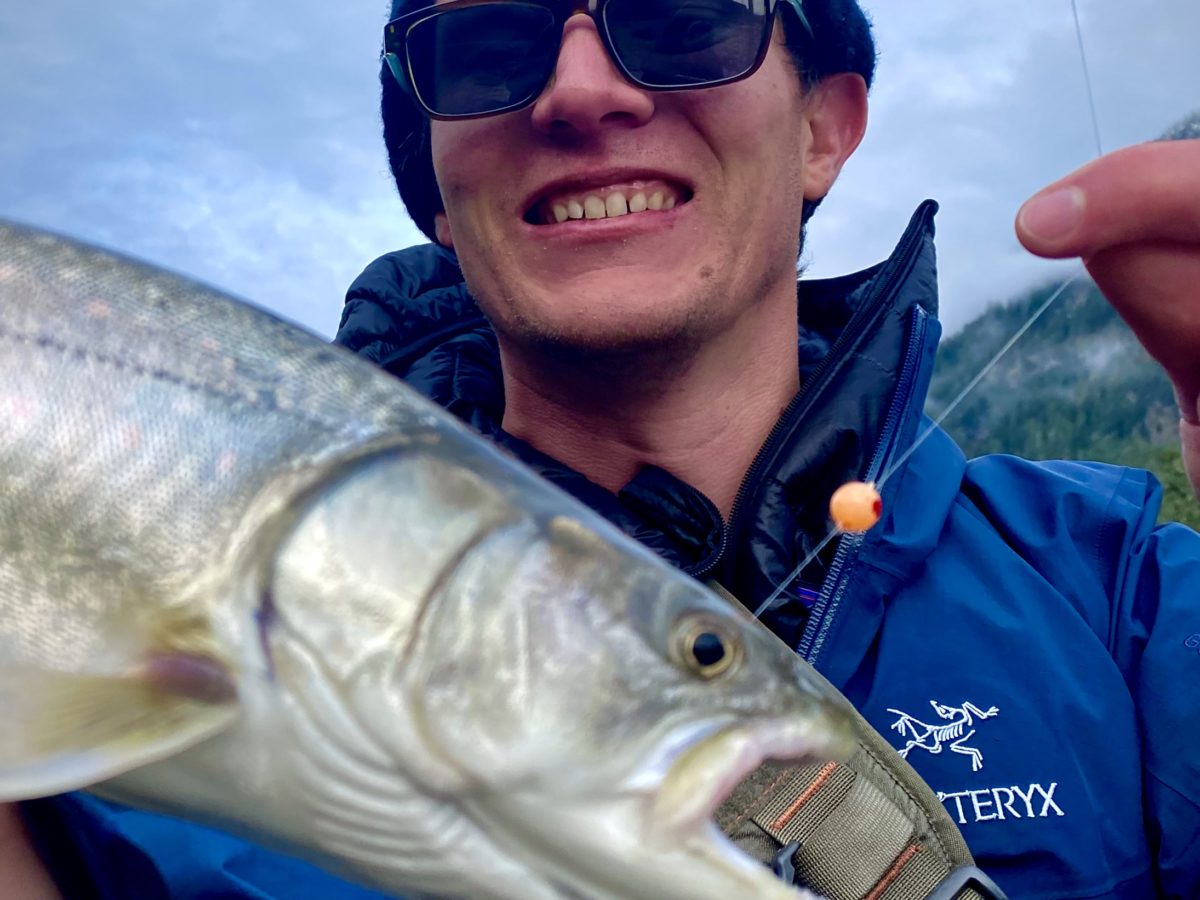OUTLOOK
It’s hard to believe that next week is December! As we wrap up November, many have been asking if we are going to have a Black Friday Sale. While the answer to that is not this year, not to worry – we are still planning on hosting our annual Boxing Week Sale, with appropriate COVID precautions in place. If you are reading this on our website, or social media feeds, get signed up for the newsletter so you can receive the report every week in your inbox but also be the first to see the SALES LIST that will come out just before Christmas. If you are reading this in your email, then you already know the drill.
On the fishing front, we are in a time of transition. Salmon fishing is slowing down on our rivers, steelhead season is just around the corner and egg eater season is in full swing. We are also seeing prawning and winter chinook season starting up so, if you want to get outside for some good R & R with one of the best outdoor, socially distanced activities on the planet, we have you covered!
We have a Valley Steelhead outlook to teach you a little about the steelhead season. There are a few options for salmon fishing and Taylor goes over that in the salmon fishing overview and Matt has some intel on the Squamish System and the egg eaters.
We also had some fun this week with prawning and winter chinook fishing in the harbour and up Howe Sound. It is a great activity to do this time of year and is commonly overlooked – Go down to docks, check up on your boat, fire up the engine, get away from the city, bring home dinner! Check out Jason’s Saltwater report for more details.
If you are stuck at home, we don’t have the Video Version of the report this week, it will be out next week, but we do have a very cool Sculpin Pattern Video from Jordan.
This pattern does not take too long but it is going to challenge your fly-tying skills. It uses some advanced tying techniques and is perfect for killing some time indoors this weekend. Oh Yeah, it will also be a go too winter bull trout/steelhead pattern for the local flows over the next few months. Check that video out in the Feature Fly Section below.
If you missed the Video Report from last week,
Click Here: https://youtu.be/CRmVTAyJYMA
On to the Report!
CLASSES AND COURSES
While our classes for 2020 have wrapped we’re working hard on our 2021 course offerings. Keep an eye on your inbox for the full listing of courses to be released next week.
FRESHWATER FISHING REPORTS
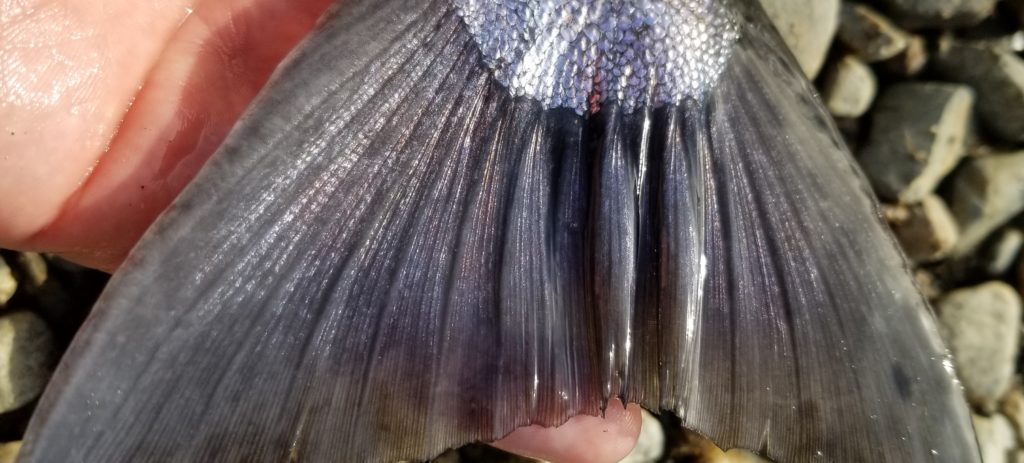
Fraser Valley Salmon Report Wrap-up
The salmon season is wrapping up in the Fraser Valley. Now, that’s not to say that it’s completely over; there will still be good days for late coho and chum showing up well into December in some systems, but finding clean fish will be a challenge.
As a general rule, systems on the north side of the Fraser have coho runs that show up a bit later than the south-side systems, so it makes sense that their runs end later, too. It’s worth noting that a majority of these late run Coho tend to be wild, so please treat them with respect if you encounter them. As a small aside, most systems, both north-side and south-side, get small late runs of chum as well. These late-run chums don’t really spend much time milling around at the Sand Heads, so they’re usually still in very good shape when they get to their destination.
I’ve found that the best way to target these late run fish is to cover lots of water, much like steelheading… you’re not going to catch fish if you can’t find them. There won’t be many fish around, so moving until you find them is key… no sense if fishing in one spot if nobody’s home. All the usual gear I’ve discussed this year will work, just adjust based on conditions and species present. Also, please be mindful of where you wade, as a majority of the smaller backchannels in our local systems are prime spawning habitat for chum and coho. Leave the spawning fish alone… harassing spawning salmon is illegal, and treading on redds will crush eggs, which is counterproductive if you want to catch fish a few years down the road.
All things considered, it’s been a good year for the Valley rivers. Chinook runs were decent, although nowhere near as good as last year… having said that, last year was incredibly good, so perhaps that’s an unfair benchmark. Coho returns were good, with a seemingly higher presence of bigger fish around compared to the last few years, which is nice to see. There were also a lot of jacks around, which could be a good indication that next year could also see good returns. The chum run was much better than the past two years, which is a very good thing considering poor the last two years have been. It still wasn’t an exceptionally good year, but it’s nice to see an improvement. The biggest challenge this year was water conditions… it was either too low, or two high, with poorly timed spikes and drops making things tough for weekend warriors and legitimate sportsmen. We still caught fish, though, and the fact that we had to work a bit more for them makes it even more rewarding.
It was a decent season, but now it’s time to get pumped for steelhead… get out there and scout for spots, and make sure you’re stocked up on all the essentials- beads, worms, fluorocarbon, floats, hand warmers… With that in mind check out Alex’s steelhead outlook below.
Taylor Nakatani
Valley Winter Steelhead Outlook
Well, the year is almost over. Salmon season is wrapping up quickly and while we still have a week or two left for a select few systems to produce nice coho, a lot of anglers are now looking ahead to steelhead season. I know I am!
They aren’t called “Silver Ghosts” and “The Fish of a Thousand Casts” for no reason! An anadromous rainbow trout, they are a prized sport fish due to their elusiveness and their fighting ability, with a ton of power to hold their own and typically going ballistic when hooked. Their sizes vary greatly with small 3-4lbers up to 20lb+ repeat spawners, though their average is anywhere between 6-12lbs in our local rivers in the Fraser Valley.
It takes motivation of steel to be a dedicated steelheader, no pun intended. Think of it more as a hunt than going out for a quick bite or two, and the name of the game is to cover as much ground as you can in the hopes of running across a couple fish. It is not uncommon to get skunked multiple trips in a row and, as such, this is really the fishery that separates the hardcores from the casual anglers. Not that it’s a bad thing to be a casual angler, but to effectively go steelheading can require a fair bit of commitment and time. Not to mention just the general outlook and mentality around this fishery is a complete 180 from that of salmon fishing. Their numbers are much smaller than that of salmon so rivers feel empty. However, they are there and the cool thing about steelhead is that they are in pretty much every river, stream, and creek as long as it has access to the ocean. There are a few popular rivers in the Fraser Valley that offer a great place to start though, with the one most talked about being the Vedder/Chilliwack River.
With all that said, it would seem like the odds are stacked against us anglers. They are and they aren’t. Our saving grace is that steelhead are much more aggressive than salmon, so the low hookup rates are not typically due to angling pressure or non-reactive fish but instead can be attributed to just a lack of fish. If you find one though, more than likely it will go out of its way to hit your presentation.
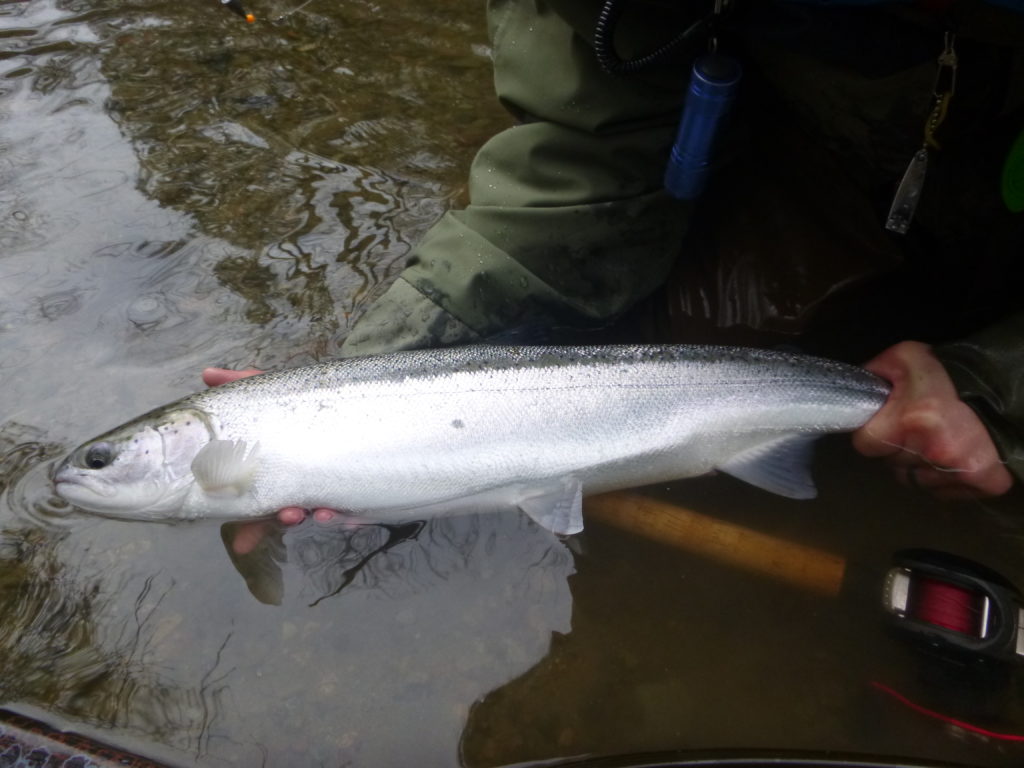
Speaking of which, how does one go about catching a steelhead? As I just mentioned, steelhead can be extremely aggressive and, as such, there are a ton of baits, lures, and flies that will entice one. On an unpressured fish it is more important to present your bait, lure, or fly properly than the actual selection of your bait, lure, or fly, to the point where you could take pretty much anything and, if presented properly, could trigger a solid bite. To give you an idea of the wide array of weapons in a steelheaders arsenal, here are just a few great options:
-cured roe
-cured shrimp
-roe bags
-dew worms
-rubber worms
-jensen eggs
-colorado blades
-beads
-wool
-curly tail grubs
-spin-n-glos
-corky
-spoons
-spinners
-float fishing jigs
-twitching jigs
-flies
It doesn’t stop there either, but I digress. Let’s talk about the different setups to use:
Drifting setups – This consists of a 10’6-11’6″ medium-light to medium-heavy powered drift rod in a baitcasting or centrepin configuration. Your reels should be loaded with 15-20lb mono. I personally lean towards the heavier stuff especially if I plan to fish a lot of pocket water. Fluorocarbon leaders in the 8-15lb range are adequate depending again on the type of water you plan to be fishing. This will be your roe, shrimp, beads, worms, colorado blades, and float fishing jig setup.
Casting setups – Coming in much shorter than their drifting counterparts, the casting setups are used primarily for throwing spoons, spinners, and twitching jigs. You will want a spinning or baitcasting setup in the 7′-9′ range and medium-light to medium-heavy power. Braid is the name of the game here and can range from 20lb to 40lb braid depending on your reel size and the water turbulence. Leaders are not necessary when clarity isn’t gin clear, but I typically run a 12-15lb fluorocarbon leader that gives me an advantage in clear conditions and allows me to break off if I get snagged up.
Fly setups – the crowning achievement for many anglers is getting a steelhead on the fly. These fish are already hard enough to catch on gear, but on the fly, it turns into a completely different beast. You will want a 7-8 weight rod with a sink tip for winter steelhead. Tippet material is typically 15lb Maxima Ultragreen which gives you some stealth but also has the added benefit of some shock absorption. Your fly choice will vary greatly depending on the situation, but a few starters are egg sucking leeches, squamish poachers, dalai lamas, general practitioners, dirk wigglers, wooly buggers, stoneflies, and a myriad of egg patterns. Don’t worry so much as to picking the exact fly listed though; lots of different style intruders will work if presented properly to the right fish.
There you have it: a quick and dirty run down on what we can look forward to for the next 5 months. We will be picking up the steelhead reports pretty soon. A couple of rivers in the Valley will get a trickle of fish starting in December, but the real fun hits in January and goes right through to end of April. If you need help getting started, come visit us at the shop and we can get you sorted out!
Alex Au-Yeung
Squamish River Fishing Report
This time of year, one of our favorite fisheries is for the egg eaters – all the species that feast on eggs disturbed from gravel during the salmon spawn. You can tackle this fishery on almost any system that has salmon and the key is to local areas of salmon spawning and fish down stream of these concentrations.
Note: Be very respectful of the areas where salmon are spawning, see notes below.
The Squamish System is a great option for this fishery. You can use gear rods or fly rods to imitate this food source and we recommend beads because not only are they extremely good at imitating real salmon eggs but when we rig them 2 inches above a hook, they deep hook way less fish. Come down to the shop and we can show you how we rig this up. We have some cool rigging options that make life easier with cold hands.
On the fishing side of things, you usually want to see a river that is dropping after a storm. It looks as though there will be a good dump of rain today, Friday, as you guys are reading this so it could be a good weekend.
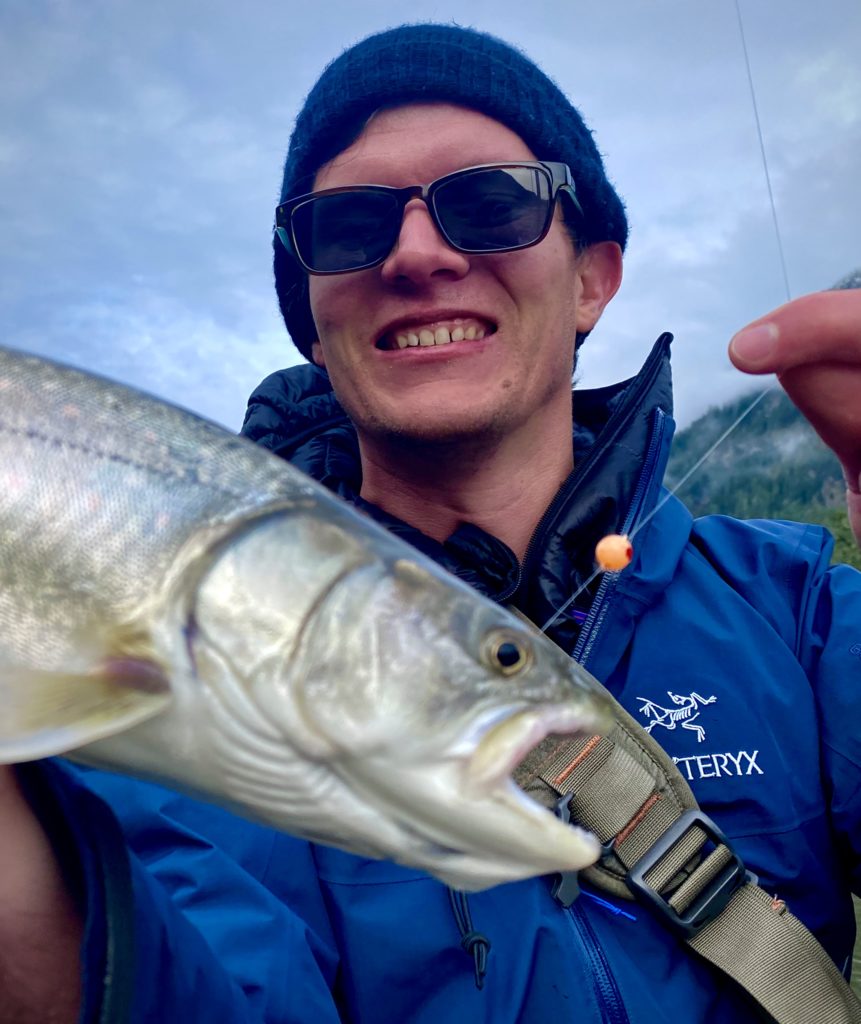
We found some fish last weekend but I won’t lie, it was a challenging weekend and I did not like the number of chum that I saw spawning. I found a few in the “usual” spots but did not see as many as I had hoped for. I saw more than last season but, historically, I have been fishing on the 20th of November for 13 years now and I did not see the numbers of chum carcasses or bones that I am used too.
One weekend is not enough of a sample size and we need more scientific methods to gauge run size on this system but concerns of chum numbers seem to have some ground.
I still think there is going to be lots of opportunity to bead fish on the system but I might focus more on the lower river where I saw more salmon spawning.
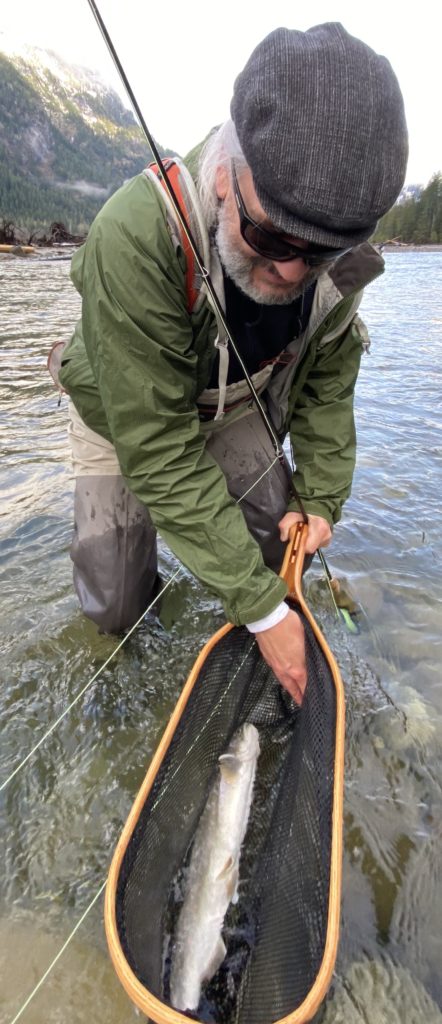
If you want to tackle this fishery check out this video:
https://www.youtube.com/watch?v=v5yZEjYN6dE&t=884s
Important note on this fishery: We ask everyone to be very respectful of walking through areas where the salmon are spawning. This also means respecting small tributaries. Even if there are no salmon present, avoid walking down the middle of these smaller pieces of water as there may have been salmon spawning there in past days. This goes for all salmon bearing streams this time of year but is hyper critical on the Squamish where spawning habitat is quite unstable. Also, all unlisted tributaries are closed to fishing on the Squamish.
Tight Lines!
Matt Sharp
FEATURE FLY
Jordan’s Turkey Dinner Sculpin Pattern
Main Body:
Hook: Gamakatsu B10S #2 (Any wide-gap hook will suffice though)
Thread: UTC 140 Hot Pink
Eyes: XL Mono
Thread: UTC 140 White (Colour to match forage species)
Body: EZ Minnow Body, (Any mylar body can be used)
Wing: Black-barred White Rabbit
Rubber Legs: Colour/Brand of choice
Composite Loop:
Gill: UV Hot Orange Ice Dub
Collar: Peacock Ice Dub
Collar: Mottled Ozark Turkey
As many of you know already, I like to swing big, meaty flies for resident and anadromous char, including both bull trout and dolly varden. As opportunistic as they are, I do like the challenge of fishing big flies for big fish. This is not the most numerically effective way to fish for them, as I probably catch more fish on smaller flies, but I find that a fish that is willing to track, hunt, or kill something bigger is usually a quality fish.
With that aside, sculpin patterns and other similar patterns representing forage fish in natural colours should always be considered, but I do like to fish the colour white quite a bit. If I’m ever unsure of what colour to use, I usually tie on white. Whether or not it’s a simple slump buster, or my custom C3 sculpin, I always have some white sculpins in my kit.
As you’ll see in the video, this fly is actually quite simple, with the most difficult part being the composite loop. When starting out and learning, you’ll quickly realize that less is more. You can always do a couple sparser loops if you find that easier at first. Another tip is to prepare all your materials, as well as prepare the composite loop material ahead of time, having them already ‘assembled’. This will help with speed and consistency as it allows you to see each composite loop laid out side-by-side next to each other, making sure they’re all dressed the same.
Feel free to add in other materials as you see fit- composite loops have no limits, and are a unique and durable way to tie big, meaty flies. Following the same design and steps with different colours is also a great idea, with olive/brown being another popular combination.
If you live in parts of the world where fish feed on cichlids (Florida, Texas, Hawai’i, etc.), tying this pattern in matching colours can be a great idea as well. Remember, there are no limits to colours or creativity.
Chuck and duck,
Jordan Simpson
SALTWATER FISHING REPORTS
You may have noticed there was no saltwater report last week. Throughout the winter, I am going to do a report every second week as things just don’t change that much during this time of year.
I would say we are officially in winter chinook season now and the fishing will usually remain decent right up until April when we start to see migratory chinook show up in larger numbers and we move to other productive locations. So, time to bunker down for the winter season, keep an eye on those weather patterns and pick your days.
Speaking of picking your days, we got lucky on Wednesday this week. Tuesday I was supposed to go out but cancelled because of the heavy rains and SE winds gusting to 45 knots. Wednesday was the total opposite. It ended up being flat calm, the rain never showed up, and we even got some sun!
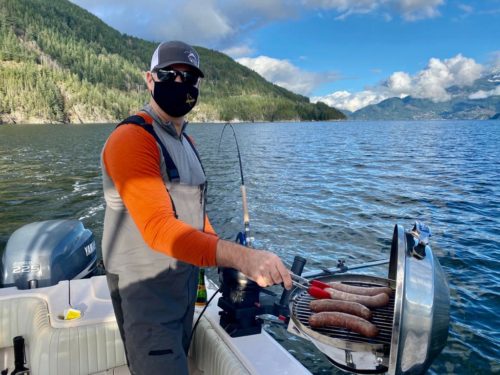
The fish decided to co-operate on Wednesday as well. This was a welcome change, because the last 2 trips out I actually had pretty tough fishing even though others were able to put some decent fish in the box on the same days. In the winter, it often boils down to being in the right place at the right time. With the shorter days, you usually only get one tide change in, so if you are in the wrong place that day, that’s how it goes. When you are in the right place for the tide change, you can get some nice fish, like these ones.
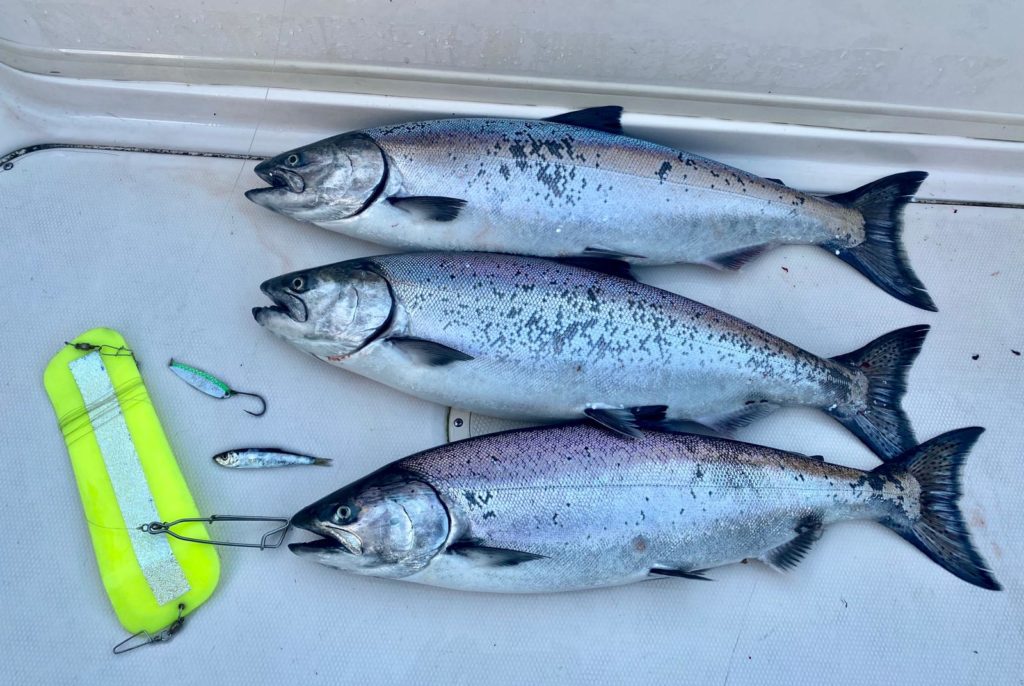
One of the more productive setups on my last trip was a Kingfisher Irish Cream spoon in size 3.0. The spoon was fished “naked”, so no flasher. For added attraction, a dummy flasher was used off the cannonball, in this case an Oki Tackle Salty Dawg. I like to run a 60-inch lead on the dummy flasher, then put my clip on about 2-3 feet above where the flasher is clipped on (clip the flasher on at the cannonball or a few inches above). Then I run the spoon about 6-7 feet off the clip, which is a 60-inch clip because my booms are extended to that length. This length of release clip makes it easier to work with them at the side of the boat when you are setting your gear. Some anglers use a shorter lead to your dummy flasher or shorter release clips, but this system works well for me and with the longer booms. If I was using riggers that had 30-inch or 48-inch booms I would use those lengths for release clip and to the flasher.
The key to success with this rig is keeping that release clip position on the rigger wire or braid, only 2-3 feet up from the dummy flasher. You generally won’t get a tangle on the drop down or when trolling because the drag of the flasher keeps it back and the tension on your rod lifts the release clip a bit as well. You don’t want your spoon too far up and too far back from the dummy flasher. A lot of people get worried about tangles, so they put their clip 5 or 6 feet above the dummy, and in my experience, this just doesn’t seem to be very productive. Your spoon is too far away from the attraction radius of that flasher. I am sure there are fisheries where having your spoon further up and further back can be deadly, but when fishing deep for winter chinook, this hasn’t been my experience. Give this setup a try, because fighting the fish with no flasher is a lot of fun! Stay tuned for some videos on the Pacific Angler YouTube channel on how to set this up.
I also dropped some prawn traps this week. It was pretty solid and very few of them had berries, less than 1%. The ensuing prawn tacos were well received.
See you in the shop or on the water,
Jason Tonelli


